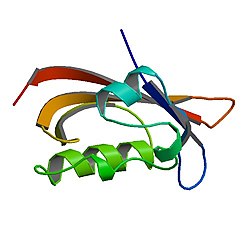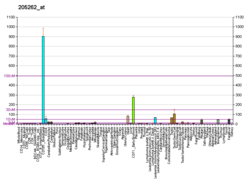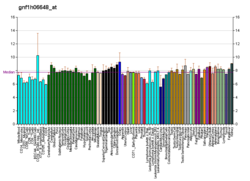hERG
hERG (the human Ether-à-go-go-Related Gene) is a gene (KCNH2) that codes for a protein known as Kv11.1, the alpha subunit of a potassium ion channel. This ion channel (sometimes simply denoted as 'hERG') is best known for its contribution to the electrical activity of the heart: the hERG channel mediates the repolarizing IKr current in the cardiac action potential, which helps coordinate the heart's beating.
When this channel's ability to conduct electrical current across the cell membrane is inhibited or compromised, either by application of drugs or by rare mutations in some families,[5] it can result in a potentially fatal disorder called long QT syndrome. Conversely, genetic mutations that increase the current through these channels can lead to the related inherited heart rhythm disorder Short QT syndrome.[6] A number of clinically successful drugs in the market have had the tendency to inhibit hERG, lengthening the QT and potentially leading to a fatal irregularity of the heartbeat (a ventricular tachyarrhythmia called torsades de pointes).[7] This has made hERG inhibition an important antitarget that must be avoided during drug development.[8]
hERG has also been associated with modulating the functions of some cells of the nervous system[9] and with establishing and maintaining cancer-like features in leukemic cells.[10]
Contents
Function[edit]
hERG forms the major portion of one of the ion channel proteins (the 'rapid' delayed rectifier current (IKr)) that conducts potassium (K+) ions out of the muscle cells of the heart (cardiac myocytes), and this current is critical in correctly timing the return to the resting state (repolarization) of the cell membrane during the cardiac action potential.[8] Sometimes, when referring to the pharmacological effects of drugs, the terms "hERG channels" and IKr are used interchangeably, but, in the technical sense, "hERG channels" can be made only by scientists in the laboratory; in formal terms, the naturally occurring channels in the body that include hERG are referred to by the name of the electrical current that has been measured in that cell type, so, for example, in the heart, the correct name is IKr. This difference in nomenclature becomes clearer in the controversy as to whether the channels conducting IKr include other subunits (e.g., beta subunits[11]) or whether the channels include a mixture of different types (isoforms) of hERG,[12] but, when the originally-discovered form of hERG[13] is experimentally transferred into cells that previously lacked hERG (i.e., heterologous expression), a potassium ion channel is formed, and this channel has many signature features of the cardiac 'rapid' delayed rectifier current (IKr),[14][15][16] including IKr's inward rectification that results in the channel producing a 'paradoxical resurgent current' in response to repolarization of the membrane.[17]
Structure[edit]
A detailed atomic structure for hERG based on X-ray crystallography is not yet available, but structures have recently been solved by electron microscopy.[18] In the laboratory the heterologously expressed hERG potassium channel comprises 4 identical alpha subunits, which form the channel's pore through the plasma membrane. Each hERG subunit consists of 6 transmembrane alpha helices, numbered S1-S6, a pore helix situated between S5 and S6, and cytoplasmically located N- and C-termini. The S4 helix contains a positively charged arginine or lysine amino acid residue at every 3rd position and is thought to act as a voltage-sensitive sensor, which allows the channel to respond to voltage changes by changing conformations between conducting and non-conducting states (called 'gating'). Between the S5 and S6 helices, there is an extracellular loop (known as 'the turret') and 'the pore loop', which begins and ends extracellularly but loops into the plasma membrane; the pore loop for each of the hERG subunits in one channel face into the ion-conducting pore and are adjacent to the corresponding loops of the 3 other subunits, and together they form the selectivity filter region of the channel pore. The selectivity sequence, SVGFG, is very similar to that contained in bacterial KcsA channels.[8] Although a full crystal structure for hERG is not yet available, a structure has been found for the cytoplasmic N-terminus, which was shown to contain a PAS domain (aminoacid 26-135) that slows the rate of deactivation.[19]
Genetics[edit]
Loss of function mutations in this channel may lead to long QT syndrome (LQT2), while gain of function mutations may lead to short QT syndrome. Both clinical disorders stem from ion channel dysfunction (so-called channelopathies) that can lead to the risk of potentially fatal cardiac arrhythmias (e.g., torsades de pointes), due to repolarization disturbances of the cardiac action potential.[14][20] There are far more hERG mutations described for long QT syndrome than for short QT syndrome.[5]
Drug interactions[edit]
This channel is also sensitive to drug binding, as well as decreased extracellular potassium levels, both of which can result in decreased channel function and drug-induced (acquired) long QT syndrome. Among the drugs that can cause QT prolongation, the more common ones include antiarrhythmics (especially Class 1A and Class III), anti-psychotic agents, and certain antibiotics (including quinolones and macrolides).[21]
Although there exist other potential targets for cardiac adverse effects, the vast majority of drugs associated with acquired QT prolongation are known to interact with the hERG potassium channel. One of the main reasons for this phenomenon is the larger inner vestibule of the hERG channel, thus providing more space for many different drug classes to bind and block this potassium channel.[22]
Drug development considerations[edit]
Due to the documented potential of QT-interval-prolonging drugs, the United States Food and Drug Administration issued recommendations for the establishment of a cardiac safety profile during pre-clinical drug development: ICH S7B.[23] The nonclinical evaluation of the potential for delayed ventricular repolarization (QT interval prolongation) by human pharmaceuticals, issued as CHMP/ICH/423/02, adopted by CHMP in May 2005. Preclinical hERG studies should be accomplished in GLP environment.
Naming[edit]
The hERG gene was first named and described in a paper by Jeff Warmke and Barry Ganetzky, then both at the University of Wisconsin–Madison.[24] The hERG gene is the human homolog of the Ether-à-go-go gene found in the Drosophila fly; Ether-à-go-go was named in the 1960s by William D. Kaplan and William E. Trout, III, while at the City of Hope Hospital in Duarte, California. Ref: The behavior of four neurological mutants of Drosophila. Genetics 61: 399-499. When flies with mutations in the Ether-à-go-go gene are anaesthetised with ether, their legs start to shake, like the dancing at the then popular Whisky A Go-Go nightclub in West Hollywood, California.
Interactions[edit]
HERG has been shown to interact with the 14-3-3 epsilon protein, encoded by YWHAE.[25]
See also[edit]
References[edit]
- ^ a b c GRCh38: Ensembl release 89: ENSG00000055118 - Ensembl, May 2017
- ^ a b c GRCm38: Ensembl release 89: ENSMUSG00000038319 - Ensembl, May 2017
- ^ "Human PubMed Reference:".
- ^ "Mouse PubMed Reference:".
- ^ a b Hedley PL, Jørgensen P, Schlamowitz S, Wangari R, Moolman-Smook J, Brink PA, Kanters JK, Corfield VA, Christiansen M (2009). "The genetic basis of long QT and short QT syndromes: a mutation update". Hum. Mutat. 30 (11): 1486–511. doi:10.1002/humu.21106. PMID 19862833.
- ^ Bjerregaard, Preben (2018-03-02). "The diagnosis and management of short QT syndrome". Heart Rhythm. 15 (8): 1261–1267. doi:10.1016/j.hrthm.2018.02.034. ISSN 1556-3871. PMID 29501667.
- ^ "hERG safety". Cyprotex. Retrieved 9 October 2018.
- ^ a b c Sanguinetti MC, Tristani-Firouzi M (March 2006). "hERG potassium channels and cardiac arrhythmia". Nature. 440 (7083): 463–9. doi:10.1038/nature04710. PMID 16554806.
- ^ Chiesa N, Rosati B, Arcangeli A, Olivotto M, Wanke E (June 1997). "A novel role for HERG K+ channels: spike-frequency adaptation". J. Physiol. 501 (2): 313–8. doi:10.1111/j.1469-7793.1997.313bn.x. PMC 1159479. PMID 9192303. Overholt JL, Ficker E, Yang T, Shams H, Bright GR, Prabhakar NR (2000). "Chemosensing at the carotid body. Involvement of a HERG-like potassium current in glomus cells". Adv. Exp. Med. Biol. Advances in Experimental Medicine and Biology. 475: 241–8. doi:10.1007/0-306-46825-5_22. ISBN 978-0-306-46367-9. PMID 10849664.
- ^ Arcangeli A (2005). "Expression and role of hERG channels in cancer cells". Novartis Found. Symp. Novartis Foundation Symposia. 266: 225–32, discussion 232–4. doi:10.1002/047002142X.ch17. ISBN 9780470021408. PMID 16050271.
- ^ Weerapura M, Nattel S, Chartier D, Caballero R, Hébert TE (April 2002). "A comparison of currents carried by HERG, with and without coexpression of MiRP1, and the native rapid delayed rectifier current. Is MiRP1 the missing link?". J. Physiol. 540 (Pt 1): 15–27. doi:10.1113/jphysiol.2001.013296. PMC 2290231. PMID 11927665.Abbott GW, Goldstein SA (March 2002). "Disease-associated mutations in KCNE potassium channel subunits (MiRPs) reveal promiscuous disruption of multiple currents and conservation of mechanism". FASEB J. 16 (3): 390–400. doi:10.1096/fj.01-0520hyp. PMID 11874988.Abbott GW, Sesti F, Splawski I, Buck ME, Lehmann MH, Timothy KW, Keating MT, Goldstein SA (April 1999). "MiRP1 forms IKr potassium channels with HERG and is associated with cardiac arrhythmia". Cell. 97 (2): 175–87. doi:10.1016/S0092-8674(00)80728-X. PMID 10219239.
- ^ Jones EM, Roti Roti EC, Wang J, Delfosse SA, Robertson GA (October 2004). "Cardiac IKr channels minimally comprise hERG 1a and 1b subunits". J. Biol. Chem. 279 (43): 44690–4. doi:10.1074/jbc.M408344200. PMID 15304481.Robertson GA, Jones EM, Wang J (2005). "Gating and assembly of heteromeric hERG1a/1b channels underlying I(Kr) in the heart" (Submitted manuscript). Novartis Found. Symp. Novartis Foundation Symposia. 266: 4–15, discussion 15–8, 44–5. doi:10.1002/047002142X.ch2. ISBN 9780470021408. PMID 16050259.
- ^ Warmke JW, Ganetzky B (April 1994). "A family of potassium channel genes related to eag in Drosophila and mammals". Proc. Natl. Acad. Sci. U.S.A. 91 (8): 3438–42. doi:10.1073/pnas.91.8.3438. PMC 43592. PMID 8159766.Trudeau MC, Warmke JW, Ganetzky B, Robertson GA (July 1995). "HERG, a human inward rectifier in the voltage-gated potassium channel family". Science. 269 (5220): 92–5. doi:10.1126/science.7604285. PMID 7604285.Sanguinetti MC, Jiang C, Curran ME, Keating MT (April 1995). "A mechanistic link between an inherited and an acquired cardiac arrhythmia: HERG encodes the IKr potassium channel". Cell. 81 (2): 299–307. doi:10.1016/0092-8674(95)90340-2. PMID 7736582.
- ^ a b Sanguinetti MC, Jiang C, Curran ME, Keating MT (1995). "A mechanistic link between an inherited and an acquired cardiac arrhythmia: HERG encodes the IKr potassium channel". Cell. 81 (2): 299–307. doi:10.1016/0092-8674(95)90340-2. PMID 7736582.
- ^ Trudeau MC, Warmke JW, Ganetzky B, Robertson GA (July 1995). "HERG, a human inward rectifier in the voltage-gated potassium channel family". Science. 269 (5220): 92–5. doi:10.1126/science.7604285. PMID 7604285.
- ^ Robertson GA, Jones EM, Wang J (2005). "Gating and assembly of heteromeric hERG1a/1b channels underlying I(Kr) in the heart" (Submitted manuscript). Novartis Found. Symp. Novartis Foundation Symposia. 266: 4–15, discussion 15–8, 44–5. doi:10.1002/047002142X.ch2. ISBN 9780470021408. PMID 16050259.
- ^ Robertson GA (March 2000). "LQT2 : amplitude reduction and loss of selectivity in the tail that wags the HERG channel". Circ. Res. 86 (5): 492–3. doi:10.1161/01.res.86.5.492. PMID 10720408.
- ^ Wang W, MacKinnon R (2017). "Cryo-EM Structure of the Open Human Ether-à-go-go-Related K+ Channel hERG". Cell. 169 (3): 422–430.e10. doi:10.1016/j.cell.2017.03.048. PMC 5484391. PMID 28431243.
- ^ Morais Cabral JH, Lee A, Cohen SL, Chait BT, Li M, Mackinnon R (November 1998). "Crystal structure and functional analysis of the HERG potassium channel N terminus: a eukaryotic PAS domain". Cell. 95 (5): 649–55. doi:10.1016/S0092-8674(00)81635-9. PMID 9845367.
- ^ Moss AJ, Zareba W, Kaufman ES, Gartman E, Peterson DR, Benhorin J, Towbin JA, Keating MT, Priori SG, Schwartz PJ, Vincent GM, Robinson JL, Andrews ML, Feng C, Hall WJ, Medina A, Zhang L, Wang Z (2002). "Increased risk of arrhythmic events in long-QT syndrome with mutations in the pore region of the human ether-a-go-go-related gene potassium channel". Circulation. 105 (7): 794–9. doi:10.1161/hc0702.105124. PMID 11854117.
- ^ Sanguinetti MC, Tristani-Firouzi M (2006). "hERG potassium channels and cardiac arrhythmia". Nature. 440 (7083): 463–9. doi:10.1038/nature04710. PMID 16554806.
- ^ Milnes JT, Crociani O, Arcangeli A, Hancox JC, Witchel HJ (2003). "Blockade of HERG potassium currents by fluvoxamine: incomplete attenuation by S6 mutations at F656 or Y652". Br. J. Pharmacol. 139 (5): 887–98. doi:10.1038/sj.bjp.0705335. PMC 1573929. PMID 12839862.
- ^ https://www.fda.gov/downloads/Drugs/GuidanceComplianceRegulatoryInformation/Guidances/ucm074963.pdf
- ^ Warmke JW, Ganetzky B (April 1994). "A family of potassium channel genes related to eag in Drosophila and mammals". Proc. Natl. Acad. Sci. U.S.A. 91 (8): 3438–42. doi:10.1073/pnas.91.8.3438. PMC 43592. PMID 8159766.
- ^ Kagan A, Melman YF, Krumerman A, McDonald TV (Apr 2002). "14-3-3 amplifies and prolongs adrenergic stimulation of HERG K+ channel activity". EMBO J. 21 (8): 1889–98. doi:10.1093/emboj/21.8.1889. PMC 125975. PMID 11953308.
Further reading[edit]
- Vincent GM (1998). "The molecular genetics of the long QT syndrome: genes causing fainting and sudden death". Annu. Rev. Med. 49: 263–74. doi:10.1146/annurev.med.49.1.263. PMID 9509262.
- Ackerman MJ (1998). "The long QT syndrome: ion channel diseases of the heart". Mayo Clin. Proc. 73 (3): 250–69. doi:10.4065/73.3.250. PMID 9511785.
- Taglialatela M, Castaldo P, Pannaccione A, Giorgio G, Annunziato L (1998). "Human ether-a-gogo related gene (HERG) K+ channels as pharmacological targets: present and future implications". Biochem. Pharmacol. 55 (11): 1741–6. doi:10.1016/S0006-2952(98)00002-1. PMID 9714291.
- Bjerregaard P, Gussak I (2005). "Short QT syndrome: mechanisms, diagnosis and treatment". Nat Clin Pract Cardiovasc Med. 2 (2): 84–7. doi:10.1038/ncpcardio0097. PMID 16265378.
- Gutman GA, Chandy KG, Grissmer S, Lazdunski M, McKinnon D, Pardo LA, Robertson GA, Rudy B, Sanguinetti MC, Stühmer W, Wang X (2005). "International Union of Pharmacology. LIII. Nomenclature and molecular relationships of voltage-gated potassium channels". Pharmacol. Rev. 57 (4): 473–508. doi:10.1124/pr.57.4.10. PMID 16382104.









